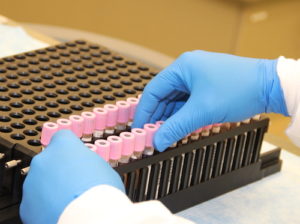Kaiser Permanente analysis identifies 48 new genome locations associated with the common malady
A Kaiser Permanente genetic analysis found 82 locations on the human genome associated with migraine, 48 of them newly identified, including 3 specific to women, who experience migraine much more frequently than men.
The study, published July 22 in Communications Biology, found migraine associations in areas of the genome identified in previous research to be related to motion sickness, psychiatric conditions, and gastrointestinal disorders. The study also found strong genetic correlations between migraine and neck, shoulder, or back pain, suggesting shared genetic factors and pathways underlying those conditions.

The findings add to the understanding of a common yet complex headache disorder, said lead author Hélène Choquet, PhD, a research scientist with the Kaiser Permanente Division of Research. “It’s very complex and very interesting,” she said. “Future studies can integrate this genetic information and look more at the individual patient level and the symptoms patients experience when they have a migraine.”
Migraine headaches affects about 12% of the U.S. population and may be associated with additional symptoms such as sensitivity to light and sound, nausea, and vomiting. People who get migraines often have family members who also have them.
The analysis was a genome-wide association meta-analysis (GWAS) that used patient health and genetic data for 930,321 people, 88,526 of them with migraine.
The data came from the Genetic Epidemiology Research on Adult Health and Aging (GERA) cohort, a group of more than 100,000 Kaiser Permanente Northern California members who volunteered their genetic and medical information for research. GERA is part of the Kaiser Permanente Research Program on Genes, Environment and Health, which is associated with the Kaiser Permanente Research Bank. Researchers also used data from the UK Biobank, which contains genetic and health information from about a half million residents of the United Kingdom, and publicly available data from the International Headache Genetics Consortium (IHGC).
The genetics of migraine has been studied in the past, mainly by the IHGC, but most of the populations involved were of European ancestry. The GERA cohort includes some East Asian, Black, and Hispanic/Latino people, producing a more diverse sample. This study confirmed genome locations for migraine in 78% of the locations identified in the largest previous study conducted by the IHGC.
“Information about genes and biological pathways shared by migraine and other conditions could help researchers explore the physiology of what is happening in the body when a migraine takes place,” Choquet said. “That understanding can in turn lead to better treatments for migraine and identification of related conditions in patients.”

Another step for future research, Choquet said, would be to examine the identified genes and how they are expressed in specific tissue types in the body to better understand the physiology of migraine and its wide range of accompanied symptoms.
The study was initiated several years ago by senior author Alice R. Pressman, PhD, MS, a former Division of Research investigator who is now executive director of Sutter Health’s Center for Health Systems Research. It builds on work by Pressman and colleagues who, in 2016, published an algorithm for identifying patients with migraine based on information in Kaiser Permanente’s electronic medical record. “Including the right patients was a key strength for this analysis,” Choquet said.
The study was funded by a grant from the National Institute for Neurological Disorders and Stroke.
Other co-authors were Andrew L. Avins, MD, MPH, Jie Yin, MS, and Brandon H. Horton of the Division of Research; Alice S. Jacobson, MS, and Eric Jorgenson, PhD, both formerly of the Division of Research; and Thomas J. Hoffman, PhD, of UC San Francisco.
# # #
About the Kaiser Permanente Division of Research
The Kaiser Permanente Division of Research conducts, publishes and disseminates epidemiologic and health services research to improve the health and medical care of Kaiser Permanente members and society at large. It seeks to understand the determinants of illness and well-being, and to improve the quality and cost-effectiveness of health care. Currently, DOR’s 600-plus staff is working on more than 450 epidemiological and health services research projects. For more information, visit divisionofresearch.kaiserpermanente.org or follow us @KPDOR.





This Post Has 0 Comments